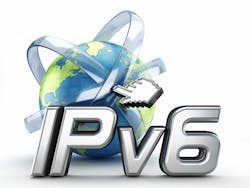Not long ago, we all heard that the number of IP addresses using the current IPv4 protocol would soon run out and that we needed to switch to IPv6 fast. Then, suddenly, talk about IPv6 seemed to die down. Did the need for it disappear? Did someone figure out a way to extend IPv4 so we wouldn't have to make the switch?
The answer to both of these questions, ultimately, is “no” and the pending need to update our networks to handle IPv6 is fast approaching. With some three trillion devices predicted to be connected to the Internet by 2020 (just four years away)—the countdown clock to IPv6 is only ticking louder and louder.
I spoke recently with Frank Williams, CEO of Statseeker (a network monitoring software company), about the need for industry to get up to speed with IPv6.
A key point Williams stressed about IPv6 is that it is not backward compatible with IPv4. “Devices built to run on IPv4 cannot work on an IPv6 network, and IPv6 devices will not work on IPv4 networks,” he said. “Most of the modern operating systems have support for IPv6, but some of them, like Windows 10, automatically prefer IPv4 networks. And for a connection to operate completely on IPv6, all the devices in the route between your origin and destination have to be IPv6, or you will find yourself drilling down to IPv4 for part of the route. That means that all the routers, switches, wifi access points and base stations, cable modems, DSL routers—every device on your network—must be switched out for an IPv6 device.”
Williams stressed that the need for industry to adopt IPv6 is going to be increasingly important as the Industrial Internet of Things (IIoT) becomes more prevalent. The reason? Because IIoT will, eventually, be comprised of sensors that are natively Ethernet. We’ve already seen this move in the industrial control system space with controllers and drives, and we’re increasingly seeing it take place with industrial sensors too (see “Adapting Sensors for Industrial Ethernet”).
“This means that a whole lot of IP addresses will be needed and IPv4 just won’t cut it,” said Williams. “So if you are the administrator of an industrial network, you should start looking at becoming an IPv6 network as soon as you can, both wired and wireless.”
I asked Williams about Network Address Translation (NAT), a communication method designed to allow devices on a private network to access the Internet through a single public IP address. Using NAT, outbound connections appear to come from the single IP address, while inbound connections are mapped to specific devices on the internal network behind the single IP address. Supporters of NAT say it removes the need for large numbers of public IP addresses via IPv6 while also increasing security by obscuring details of the network behind a single address.
Williams said he thinks NAT has helped delay the need to deploy IPv6 in the near term; however, it “hasn't eliminated the need for IPv6.” He clarified his point by saying the rollout of IPv6 in internal business networks won't occur quickly, and when it does, most businesses will run a dual IPv4 and IPv6 network for some time.
Both IPv6 devices and dual IP devices (IPv4 and IPv6 capable) are available now from most of the major network appliance manufacturers.
The weak spot for NAT, according to Williams, is that if you only have limited external IP addresses, where everything is “NAT'ed through them, you limit the number of services you can deliver externally. VOIP, for example, has issues with NAT'ed environments.”
As a supplier of network management tools, Williams sees a role for his Statseeker product in the switchover process. “Whether your network is IPv4, IPv6, or a hybrid of both IP addressing schemes, you will need a strong, scalable network information manager,” he said. Beyond providing visibility down to the device and node level in a network, Statseeker also records and stores data in the same granularity, i.e., near real-time, in which it originally was recorded. This capability means there is “no loss of granularity in weekly or monthly rollups, which do not allow you to really see what is going on,” he said.


